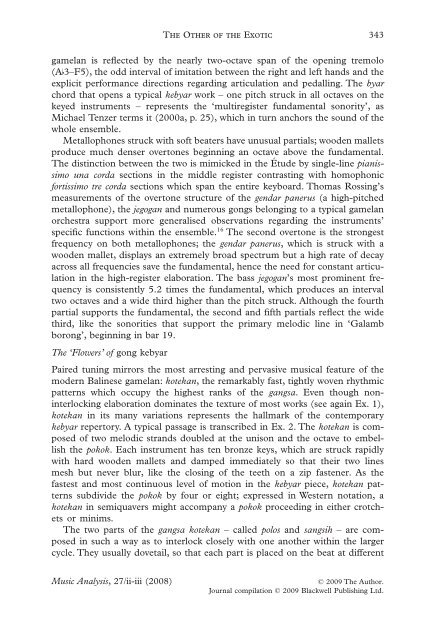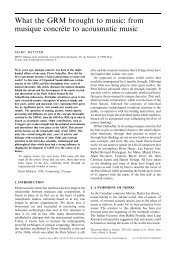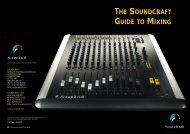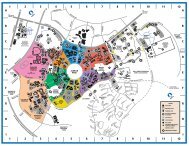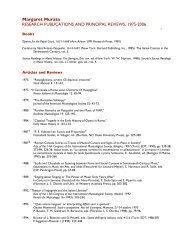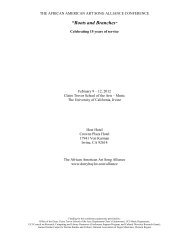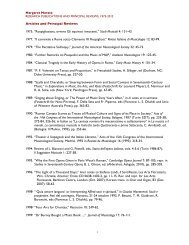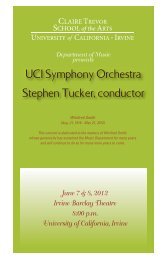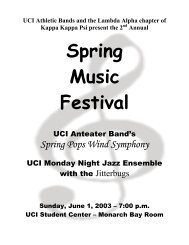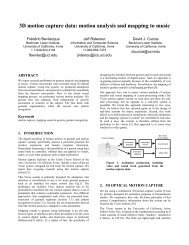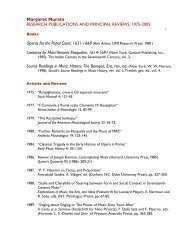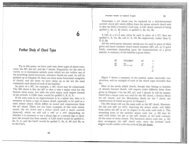amy bauer The Other of the Exotic: Balinese Music as Grammatical ...
amy bauer The Other of the Exotic: Balinese Music as Grammatical ...
amy bauer The Other of the Exotic: Balinese Music as Grammatical ...
Create successful ePaper yourself
Turn your PDF publications into a flip-book with our unique Google optimized e-Paper software.
<strong>The</strong> <strong>O<strong>the</strong>r</strong> <strong>of</strong> <strong>the</strong> <strong>Exotic</strong> 343<br />
gamelan is reflected by <strong>the</strong> nearly two-octave span <strong>of</strong> <strong>the</strong> opening tremolo<br />
(A♭3–F5), <strong>the</strong> odd interval <strong>of</strong> imitation between <strong>the</strong> right and left hands and <strong>the</strong><br />
explicit performance directions regarding articulation and pedalling. <strong>The</strong> byar<br />
chord that opens a typical kebyar work – one pitch struck in all octaves on <strong>the</strong><br />
keyed instruments – represents <strong>the</strong> ‘multiregister fundamental sonority’, <strong>as</strong><br />
Michael Tenzer terms it (2000a, p. 25), which in turn anchors <strong>the</strong> sound <strong>of</strong> <strong>the</strong><br />
whole ensemble.<br />
Metallophones struck with s<strong>of</strong>t beaters have unusual partials; wooden mallets<br />
produce much denser overtones beginning an octave above <strong>the</strong> fundamental.<br />
<strong>The</strong> distinction between <strong>the</strong> two is mimicked in <strong>the</strong> Étude by single-line pianissimo<br />
una corda sections in <strong>the</strong> middle register contr<strong>as</strong>ting with homophonic<br />
fortissimo tre corda sections which span <strong>the</strong> entire keyboard. Thom<strong>as</strong> Rossing’s<br />
me<strong>as</strong>urements <strong>of</strong> <strong>the</strong> overtone structure <strong>of</strong> <strong>the</strong> gendar panerus (a high-pitched<br />
metallophone), <strong>the</strong> jegogan and numerous gongs belonging to a typical gamelan<br />
orchestra support more generalised observations regarding <strong>the</strong> instruments’<br />
specific functions within <strong>the</strong> ensemble. 16 <strong>The</strong> second overtone is <strong>the</strong> strongest<br />
frequency on both metallophones; <strong>the</strong> gendar panerus, which is struck with a<br />
wooden mallet, displays an extremely broad spectrum but a high rate <strong>of</strong> decay<br />
across all frequencies save <strong>the</strong> fundamental, hence <strong>the</strong> need for constant articulation<br />
in <strong>the</strong> high-register elaboration. <strong>The</strong> b<strong>as</strong>s jegogan’s most prominent frequency<br />
is consistently 5.2 times <strong>the</strong> fundamental, which produces an interval<br />
two octaves and a wide third higher than <strong>the</strong> pitch struck. Although <strong>the</strong> fourth<br />
partial supports <strong>the</strong> fundamental, <strong>the</strong> second and fifth partials reflect <strong>the</strong> wide<br />
third, like <strong>the</strong> sonorities that support <strong>the</strong> primary melodic line in ‘Galamb<br />
borong’, beginning in bar 19.<br />
<strong>The</strong> ‘Flowers’ <strong>of</strong> gong kebyar<br />
Paired tuning mirrors <strong>the</strong> most arresting and perv<strong>as</strong>ive musical feature <strong>of</strong> <strong>the</strong><br />
modern <strong>Balinese</strong> gamelan: kotekan, <strong>the</strong> remarkably f<strong>as</strong>t, tightly woven rhythmic<br />
patterns which occupy <strong>the</strong> highest ranks <strong>of</strong> <strong>the</strong> gangsa. Even though noninterlocking<br />
elaboration dominates <strong>the</strong> texture <strong>of</strong> most works (see again Ex. 1),<br />
kotekan in its many variations represents <strong>the</strong> hallmark <strong>of</strong> <strong>the</strong> contemporary<br />
kebyar repertory. A typical p<strong>as</strong>sage is transcribed in Ex. 2. <strong>The</strong> kotekan is composed<br />
<strong>of</strong> two melodic strands doubled at <strong>the</strong> unison and <strong>the</strong> octave to embellish<br />
<strong>the</strong> pokok. Each instrument h<strong>as</strong> ten bronze keys, which are struck rapidly<br />
with hard wooden mallets and damped immediately so that <strong>the</strong>ir two lines<br />
mesh but never blur, like <strong>the</strong> closing <strong>of</strong> <strong>the</strong> teeth on a zip f<strong>as</strong>tener. As <strong>the</strong><br />
f<strong>as</strong>test and most continuous level <strong>of</strong> motion in <strong>the</strong> kebyar piece, kotekan patterns<br />
subdivide <strong>the</strong> pokok by four or eight; expressed in Western notation, a<br />
kotekan in semiquavers might accompany a pokok proceeding in ei<strong>the</strong>r crotchets<br />
or minims.<br />
<strong>The</strong> two parts <strong>of</strong> <strong>the</strong> gangsa kotekan – called polos and sangsih – are composed<br />
in such a way <strong>as</strong> to interlock closely with one ano<strong>the</strong>r within <strong>the</strong> larger<br />
cycle. <strong>The</strong>y usually dovetail, so that each part is placed on <strong>the</strong> beat at different<br />
<strong>Music</strong> Analysis, 27/ii-iii (2008)<br />
© 2009 <strong>The</strong> Author.<br />
Journal compilation © 2009 Blackwell Publishing Ltd.


